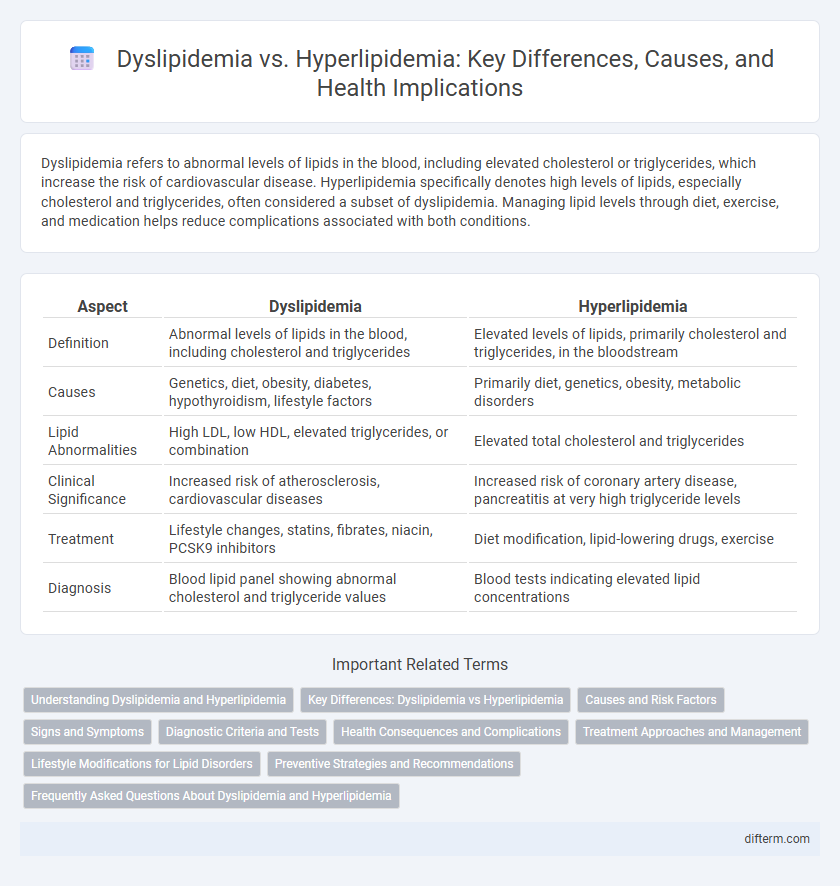Dyslipidemia refers to abnormal levels of lipids in the blood, including elevated cholesterol or triglycerides, which increase the risk of cardiovascular disease. Hyperlipidemia specifically denotes high levels of lipids, especially cholesterol and triglycerides, often considered a subset of dyslipidemia. Managing lipid levels through diet, exercise, and medication helps reduce complications associated with both conditions.
Table of Comparison
| Aspect | Dyslipidemia | Hyperlipidemia |
|---|---|---|
| Definition | Abnormal levels of lipids in the blood, including cholesterol and triglycerides | Elevated levels of lipids, primarily cholesterol and triglycerides, in the bloodstream |
| Causes | Genetics, diet, obesity, diabetes, hypothyroidism, lifestyle factors | Primarily diet, genetics, obesity, metabolic disorders |
| Lipid Abnormalities | High LDL, low HDL, elevated triglycerides, or combination | Elevated total cholesterol and triglycerides |
| Clinical Significance | Increased risk of atherosclerosis, cardiovascular diseases | Increased risk of coronary artery disease, pancreatitis at very high triglyceride levels |
| Treatment | Lifestyle changes, statins, fibrates, niacin, PCSK9 inhibitors | Diet modification, lipid-lowering drugs, exercise |
| Diagnosis | Blood lipid panel showing abnormal cholesterol and triglyceride values | Blood tests indicating elevated lipid concentrations |
Understanding Dyslipidemia and Hyperlipidemia
Dyslipidemia refers to abnormal levels of lipids in the blood, including elevated cholesterol, triglycerides, or low-density lipoprotein (LDL), while hyperlipidemia specifically denotes high levels of lipids, primarily cholesterol and triglycerides. Both conditions significantly increase the risk of cardiovascular diseases, but dyslipidemia encompasses a broader range of lipid disorders beyond just elevated levels. Effective management involves lifestyle modification and pharmacological treatment to maintain healthy lipid profiles and prevent atherosclerosis.
Key Differences: Dyslipidemia vs Hyperlipidemia
Dyslipidemia refers to abnormal levels of lipids in the blood, including high or low cholesterol and triglycerides, while hyperlipidemia specifically indicates elevated levels of lipids, mainly cholesterol and triglycerides. Dyslipidemia encompasses a broader range of lipid imbalances, such as low HDL cholesterol or high LDL cholesterol, whereas hyperlipidemia is typically characterized by increased total cholesterol or triglyceride concentrations. Effective diagnosis and treatment rely on lipid panel testing to distinguish between these conditions and tailor interventions accordingly.
Causes and Risk Factors
Dyslipidemia and hyperlipidemia both involve abnormal lipid levels but differ in specific lipid imbalances; dyslipidemia includes elevated LDL cholesterol, low HDL cholesterol, and high triglycerides, while hyperlipidemia primarily refers to high total cholesterol or LDL cholesterol. Causes of dyslipidemia include genetic mutations, poor diet high in saturated fats and trans fats, obesity, insulin resistance, and certain medications, whereas hyperlipidemia is often linked to familial hypercholesterolemia, sedentary lifestyle, and metabolic syndrome. Risk factors common to both conditions consist of diabetes, hypertension, smoking, and a family history of cardiovascular disease, increasing the likelihood of atherosclerosis and coronary artery disease.
Signs and Symptoms
Dyslipidemia and hyperlipidemia both involve abnormal lipid levels but differ in clinical presentation. Dyslipidemia may present with xanthomas, pancreatitis, or corneal arcus, highlighting impaired cholesterol metabolism. Hyperlipidemia often manifests through asymptomatic elevated cholesterol or triglycerides detected on lipid panels, with symptoms appearing only in severe cases such as eruptive xanthomas or lipemia retinalis.
Diagnostic Criteria and Tests
Dyslipidemia is diagnosed based on abnormal levels of lipids, including elevated LDL cholesterol, low HDL cholesterol, and high triglycerides, while hyperlipidemia primarily refers to elevated total cholesterol and LDL cholesterol levels. Diagnostic tests for both conditions include fasting lipid panels measuring total cholesterol, LDL, HDL, and triglycerides, with guidelines such as the Adult Treatment Panel (ATP) III criteria aiding interpretation. Advanced testing may involve lipoprotein particle analysis and genetic screening to differentiate primary from secondary causes and to tailor treatment strategies.
Health Consequences and Complications
Dyslipidemia, characterized by abnormal levels of lipids such as cholesterol and triglycerides, significantly increases the risk of atherosclerosis and cardiovascular diseases like coronary artery disease and stroke. Hyperlipidemia, a subset of dyslipidemia marked by elevated lipid levels, often leads to plaque buildup in arterial walls, causing hypertension and potential heart failure. Both conditions contribute to long-term complications including peripheral artery disease, pancreatitis, and metabolic syndrome, underscoring the importance of early diagnosis and lipid management.
Treatment Approaches and Management
Dyslipidemia treatment primarily targets specific abnormalities in lipid profiles, such as elevated LDL cholesterol or low HDL cholesterol, often using statins, fibrates, or niacin to normalize lipid levels and reduce cardiovascular risk. Hyperlipidemia management focuses broadly on lowering elevated total cholesterol and triglycerides through lifestyle modifications, including diet and exercise, complemented by pharmacologic agents like statins or omega-3 fatty acids. Both conditions require regular lipid monitoring and individualized therapy plans to optimize outcomes and prevent atherosclerotic cardiovascular disease.
Lifestyle Modifications for Lipid Disorders
Lifestyle modifications play a crucial role in managing both dyslipidemia and hyperlipidemia by targeting underlying risk factors such as diet, physical activity, and weight management. Adopting a heart-healthy diet rich in fruits, vegetables, whole grains, and omega-3 fatty acids helps reduce LDL cholesterol and triglycerides while increasing HDL cholesterol. Regular aerobic exercise and smoking cessation further improve lipid profiles and reduce cardiovascular risks associated with lipid disorders.
Preventive Strategies and Recommendations
Preventive strategies for dyslipidemia and hyperlipidemia emphasize lifestyle modifications such as adopting a heart-healthy diet rich in omega-3 fatty acids, soluble fiber, and plant sterols to reduce LDL cholesterol levels. Regular physical activity, maintaining a healthy weight, and avoiding tobacco use are critical recommendations to improve lipid profiles and reduce cardiovascular risk. Monitoring lipid levels through routine blood tests supports early intervention and personalized treatment plans to manage dyslipidemia and hyperlipidemia effectively.
Frequently Asked Questions About Dyslipidemia and Hyperlipidemia
Dyslipidemia refers to abnormal levels of lipids in the blood, including high cholesterol and triglycerides, while hyperlipidemia specifically denotes elevated lipid levels, often linked to cardiovascular risk. Common questions involve understanding the causes, such as genetic predisposition or lifestyle factors, and differences in treatment approaches like dietary changes, medications, or managing associated conditions. Monitoring lipid profiles regularly through blood tests is essential for early detection and effective management of both dyslipidemia and hyperlipidemia to prevent heart disease.
Dyslipidemia vs Hyperlipidemia Infographic

 difterm.com
difterm.com